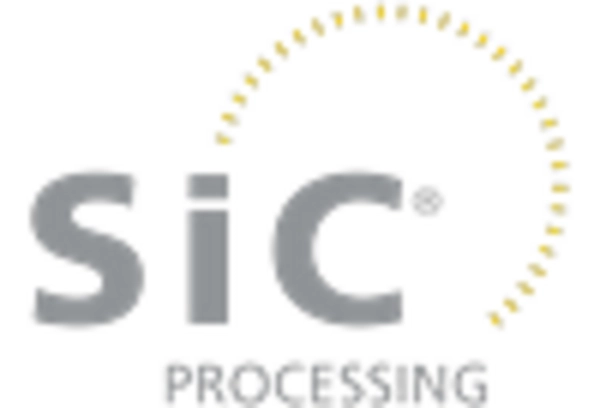Silicon Carbide Size
Market Size Snapshot
| Year | Value |
|---|---|
| 2024 | USD 2.07 Billion |
| 2032 | USD 2.99 Billion |
| CAGR (2024-2032) | 4.7 % |
Note – Market size depicts the revenue generated over the financial year
The silicon carbide market is expected to grow steadily from 2024 to 2032, when it will reach $ 2.99 billion, growing at a CAGR of 4.7 percent. This growth rate indicates a strong demand for silicon carbide due to its increased use in various industries, mainly in power electronics, the automotive industry, and the field of new energy. The high-efficiency, high-power materials required for the next generation of products will rely on the unique properties of silicon carbide. There are several factors contributing to the growth of the silicon carbide market. The growing use of electric vehicles (EVs) and the increasing demand for energy-saving solutions are two major growth drivers. Also driving the market is the development of semiconductor technology, especially the development of high-power devices. The industry's leading companies, such as Cree, Inc., ON Semiconductor, and Infineon, are actively investing in research and development, establishing strategic cooperation, and launching new products to seize market opportunities. Cree, for example, has developed silicon carbide technology for EV charging devices, which has improved the performance of EV charging devices, highlighting the important role of silicon carbide in the energy-saving and emission-reduction field.
Regional Market Size
Regional Deep Dive
The silicon carbide market is undergoing significant growth in various regions, driven by the growing demand for high-performance materials in the industries of automobiles, electronics, and renewable energy. The silicon carbide market in each region is influenced by a variety of factors, such as technological progress, government policies, and economic conditions. North America is leading the world in innovation and application development, while the Asia-Pacific region is expanding its manufacturing capacity rapidly. Europe is focusing on sustainable development and energy conservation. The Middle East and Africa have opportunities for growth due to the development of infrastructure. Latin America is gradually adopting silicon carbide technology, especially in the automobile industry.
Europe
- In Europe, with the stricter regulations and the increasing importance of the exploitation of renewable sources of energy, the demand for silicon carbide has increased. The leading company in this field is Infineon, whose products are designed for energy-saving purposes.
- The European Union's Green Deal is fostering innovation in silicon carbide technologies, encouraging collaborations between research institutions and industry players to enhance the sustainability of semiconductor manufacturing.
Asia Pacific
- Asia-Pacific is rapidly becoming a hub for silicon carbide production, with countries like China and Japan investing heavily in manufacturing capabilities, driven by the growing demand for electric vehicles and renewable energy technologies.
- Key players such as Cree and ROHM Semiconductor are expanding their operations in the region, focusing on innovations that improve the performance and cost-effectiveness of silicon carbide devices.
Latin America
- Latin America is gradually recognizing the potential of silicon carbide, particularly in the automotive sector, as countries like Brazil and Mexico seek to modernize their manufacturing processes and adopt cleaner technologies.
- Collaborations between local universities and international companies are emerging, focusing on research and development of silicon carbide applications to enhance energy efficiency in industrial processes.
North America
- The North American market is heavily influenced by the automotive industry's shift towards electric vehicles (EVs), with companies like Tesla and General Motors investing in silicon carbide technologies to enhance battery efficiency and performance.
- In recent years, the use of silicon carbide has increased considerably in the field of power electronics, mainly in the light of the new regulations relating to carbon dioxide. In this respect the Department of Energy is collaborating in a programme of research.
Middle East And Africa
- The Middle East and Africa are beginning to explore silicon carbide applications, particularly in the energy sector, as countries like Saudi Arabia and the UAE invest in renewable energy projects and smart grid technologies.
- Government initiatives aimed at diversifying economies away from oil dependency are creating opportunities for silicon carbide adoption in various sectors, including telecommunications and automotive.
Did You Know?
“Silicon carbide is known for its exceptional thermal conductivity and high breakdown electric field, making it a preferred material for high-power and high-temperature applications.” — Research and Markets
Segmental Market Size
The silicon carbide market is currently experiencing strong growth, mainly due to the high-power applications of electric vehicles (EV) and renewable energy systems. In addition, the need for energy-efficient solutions and the push for sustainable technology, especially in the fields of power electronics and electrical engineering, are driving demand. The corresponding regulations also favor the use of SiC components, which are associated with a lower energy consumption and higher efficiency. The implementation of SiC is currently in the exploitation phase, with Cree, Infineon and ON Semiconductor at the forefront. In particular, the integration of SiC in EVs by Tesla and in various renewable energy systems is impressive, demonstrating the material's versatility. The main applications are power electronics, EVs and electrical engineering, where the high thermal conductivity and efficiency of SiC are decisive. The EV trend and the sustainable drive are driving the market, while advances in manufacturing and materials science continue to shape the market's development.
Future Outlook
The silicon carbide market is expected to grow at a significant CAGR of 4.7% from 2024 to 2032. This growth is primarily due to the rising demand for high-performance materials in various applications, especially in the automotive and electrical industries. The increasing emphasis on energy efficiency and sustainability is likely to drive the demand for silicon carbide. SiC's superior heat conductivity and its application in power electronics are expected to drive the market for SiC. By 2032, it is estimated that SiC devices will account for about 20% of the total semiconductor market, indicating a high penetration rate in high-power applications. Technological advancements such as the development of more efficient manufacturing processes and the introduction of new SiC-based devices will also drive market growth. Government support for the development of green technology and the reduction of carbon emissions is also expected to boost demand for SiC solutions. The integration of SiC into 5G technology and the expansion of the electric vehicle charging network will also play a key role in shaping the market. As the industry evolves, the participants need to be flexible to seize opportunities and overcome the challenges posed by competition and supply chain dynamics.















Leave a Comment